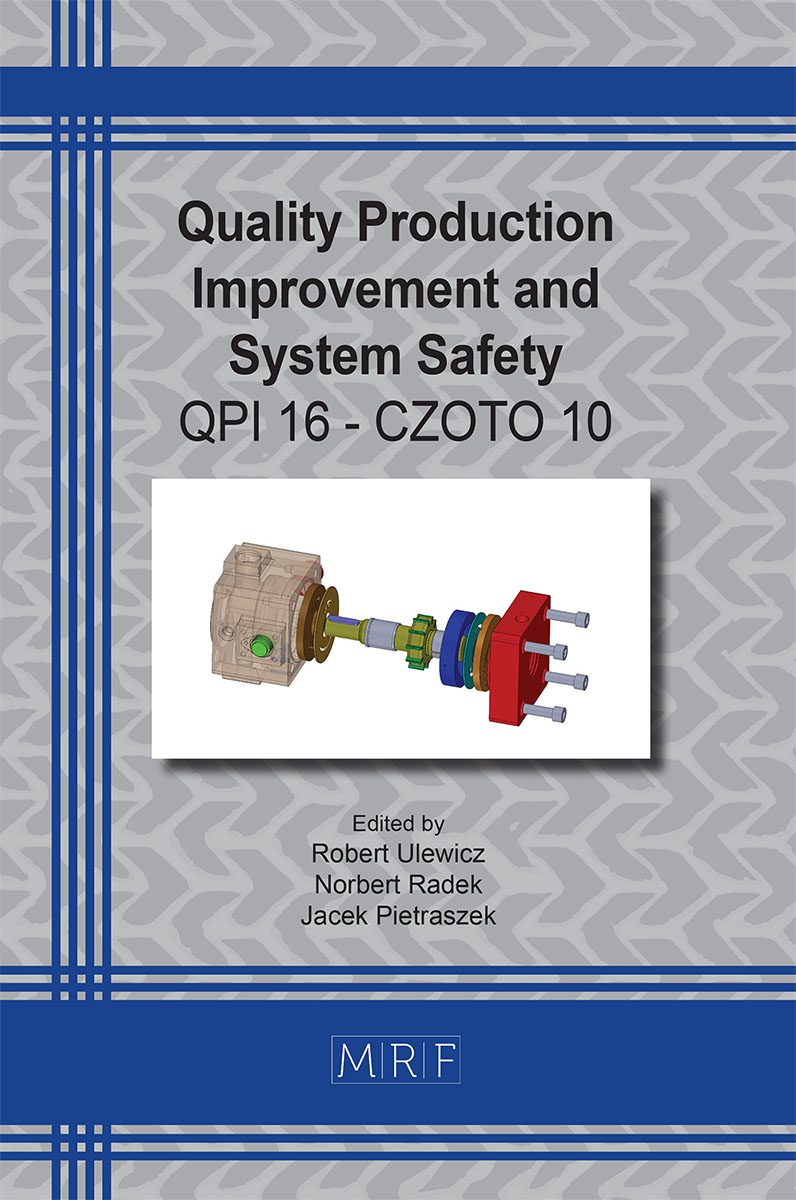The Biodegradation and the Rheological Properties of Polypropylene/Hyperbranched Polyester Blends for Industrial Applications
AL-MUTAIRI Nabeel Hasan, AL-ZUBIEDY Ali, AL-ZUHAIRI Ali J., IDZIKOWSKI Adam
download PDFAbstract. In this research, four novel types of hyperbranched polyester polymers (HBPs) were used and blended with polypropylene polymer PP, virgin VPP and recycled rPP, using a twin-screw extrusion machine. Hyperbranched polyester was added in different weight ratios (5%, 10%, and 20%). The Fourier transform spectroscopy FTIR, the water contact angle CA, the biodegradation in soil, and the rheological properties (melt flow rate MFR) of the prepared blends were investigated. The results showed that the contact angle of VPP and rPP blends has improved with the addition of HBPs, and in addition, the biodegradation results in soil showed that weight loss increased as the amount of HBPs increased in VPP and rPP blends. The rheological properties, melt flow rate MFR, showed that the addition of HBPs increased the MFR for both PP blends, VPP and rPP. In addition, it was found that the blends’ viscosity was decreased and their shear rate was increased. This is an indication that the HBPs work as a processing aid additive by increasing the shear thinning behavior.
Keywords
Polypropylene PP, Hyperbranched Polyester HBP, Contact Angle CA, Biodegradation, MFR
Published online 9/1/2023, 11 pages
Copyright © 2023 by the author(s)
Published under license by Materials Research Forum LLC., Millersville PA, USA
Citation: AL-MUTAIRI Nabeel Hasan, AL-ZUBIEDY Ali, AL-ZUHAIRI Ali J., IDZIKOWSKI Adam, The Biodegradation and the Rheological Properties of Polypropylene/Hyperbranched Polyester Blends for Industrial Applications, Materials Research Proceedings, Vol. 34, pp 109-119, 2023
DOI: https://doi.org/10.21741/9781644902691-14
The article was published as article 14 of the book Quality Production Improvement and System Safety
![]() Content from this work may be used under the terms of the Creative Commons Attribution 3.0 license. Any further distribution of this work must maintain attribution to the author(s) and the title of the work, journal citation and DOI.
Content from this work may be used under the terms of the Creative Commons Attribution 3.0 license. Any further distribution of this work must maintain attribution to the author(s) and the title of the work, journal citation and DOI.
References
[1] P. R. Deviprasad Varma. Studies on the fracture behaviour of polymer blends with special reference to PP/HDPE and PS/HIPS blends, Cochin University of Science & Technology, 2010. [online]. 2010. [viewed: 2023-01-31]. Available from: https://purl.org/purl/2625
[2] A.M.P.B. Samarasekara, E.A.P.C.D. Jayasuriya. Synthesis of biodegradable polyolefins based polymer composites using degradable natural materials, in: Proc. Int. Forestry and Environment Symp. 18 (2013) 61-72. https://doi.org/10.31357/fesympo.v18i0.1913
[3] E. Eastwood et al. Methods to improve the properties of polymer mixtures: optimizing intermolecular interactions and compatibilization, Polymer 46 2005) 3957-3970. https://doi.org/10.1016/j.polymer.2005.02.073
[4] G. Scott, D.M. Wiles. Programmed-life plastics from polyolefins: a new look at sustainability, Biomacromolecules 2001 (2) 615-622. https://doi.org/10.1021/bm010099h
[5] A. Ammala et al. An overview of degradable and biodegradable polyolefins, Prog. Polym. Sci. 2011 (36) 1015-1049. https://doi.org/10.1016/j.progpolymsci.2010.12.002
[6] D.K. Mandal et al. Radiation-induced grafting of acrylic acid onto polypropylene film and its biodegradability, Radiat. Phys. Chem. 2016 (123) 37-45. https://doi.org/10.1016/j.radphyschem.2016.02.011
[7] D.E. MacArthur, D. Waughray, M.R. Stuchtey. The new plastics economy, rethinking the future of plastics, World Economic Forum 2016. [online]. 2016. [viewed: 2023-01-31]. Available from: https://www3.weforum.org/docs/WEF_The_New_Plastics_Economy.pdf
[8] D.K. Mandal et al. Optimization of acrylic acid grafting onto polypropylene using response surface methodology and its biodegradability, Radiat. Phys. Chem. 132 (2017) 71-81. https://doi.org/10.1016/j.radphyschem.2016.12.003
[9] R. Muthuraj, M. Misra, A.K. Mohanty. Biodegradable compatibilized polymer blends for packaging applications: A literature review, J. App. Polymer Sci. 135 (2018) art. 45726. https://doi.org/10.1002/app.45726.
[10] A.I. Buthaina, K.M. Kadum. Influence of polymer blending on mechanical and thermal properties, Mod. Appl. Sci. 4 (2010) 157-161. https://doi.org/10.5539/mas.v4n9p157
[11] Ye. Hong et al. A novel processing aid for polymer extrusion: Rheology and processing of polyethylene and hyperbranched polymer blends, J. Rheol. 43 (1999) 781-793. https://doi.org/10.1122/1.550999
[12] J. Wang et al. Chain-topology-controlled hyperbranched polyethylene as effective polymer processing aid (PPA) for extrusion of a metallocene linear-low-density polyethylene (mLLDPE), J. Rheol. 52 (2008) 243-260. https://doi.org/10.1122/1.2807445
[13] N.H. Al-Mutairi, A. Al-Zubiedy, A.J. Al-Zuhairi. Hyperbranched Polyester Polymer Preparation and Study Its Effect on Some Properties of Polypropylene, Egypt. J. Chem. 65 (2022) 35-43. https://doi.org/10.21608/ejchem.2022.98747.4594
[14] N.H. Al-Mutairi, A. Al-Zubiedy. Preparation and Characterization of a Novel Hyperbranched Polyester Polymers Using A2+B3 Monomers, Prod. Eng. Arch. 29 (2023) 28 36. https://doi.org/10.30657/pea.2023.29.5
[15] A. Shenoy. Thermoplastic melt rheology and processing, 1st Ed. CRC Press, Boca Raton, 1996.
[16] H.C. Obasi, I.O. Igwe. Cassava starch-mixed polypropylene biodegradable polymer: Preparation, characterization, and effects of biodegradation products on growth of plants, Int. J. Sci. Res. 3 (2014) 802-807.
[17] M.R. Jung et al. Validation of ATR FT-IR to identify polymers of plastic marine debris, including those ingested by marine organisms, Mar. Pollut. Bull. 127 (2018) 704-716. https://doi.org/10.1016/j.marpolbul.2017.12.061
[18] M. Gopanna et al. Fourier transform infrared spectroscopy (FTIR), Raman spectroscopy and wide-angle X-ray scattering (WAXS) of polypropylene (PP)/cyclic olefin copolymer (COC) blends for qualitative and quantitative analysis, Polym. Bull. 76 (2019) 4259-4274, 2019. https://doi.org/10.1007/s00289-018-2599-0
[19] M. Guzmán, D. Giraldo, E. Murillo. Hyperbranched polyester polyol plasticized tapioca starch/low density polyethylene blends, Polimeros 27 (2017) 1-7. https://doi.org/10.1590/0104-1428.04816
[20] R. Mesias, E. Murillo. Hyperbranched polyester polyol modified with polylactic acid as a compatibilizer for plasticized tapioca starch/polylactic acid blends, Polimeros 28 (2018) 44 52. https://doi.org/10.1590/0104-1428.09516
[21] J. Zhang et al. Novel waterborne UV-curable hyperbranched polyurethane acrylate/silica with good printability and rheological properties applicable to flexographic ink, ACS Omega 2 (2017) 7546-7558. https://doi.org/10.1021/acsomega.7b00939
[22] C. Caicedo, E.A. Murillo. Structural, thermal, rheological, morphological and mechanical properties of polypropylene functionalized in molten state with maleinized hyperbranched polyol polyester, Eur. Polym. J. 118 (2019) 254-264. https://doi.org/10.1016/j.eurpolymj.2019.06.005
[23] H. Bakhshi, S. Agarwal. Hyperbranched polyesters as biodegradable and antibacterial additives, J. Mater. Chem. B 5 (2017) 6827-6834. https://doi.org/10.1039/c7tb01301a
[24] W. Gu et al. Tough, strong, and biodegradable composite film with excellent UV barrier performance comprising soy protein isolate, hyperbranched polyester, and cardanol derivative, Green Chem. 21 (2019) 3651-3665. https://doi.org/10.1039/c9gc01081e












